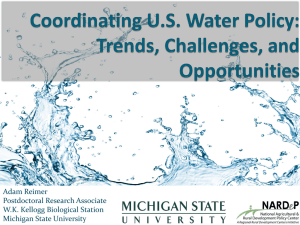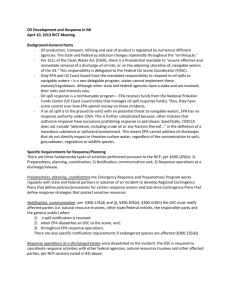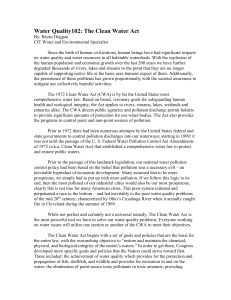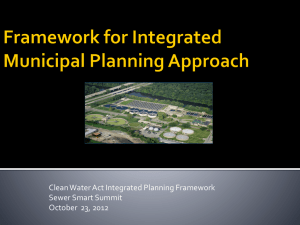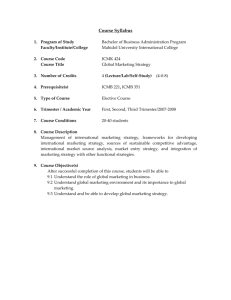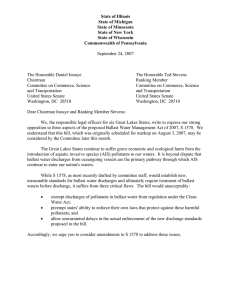Port of Oswego v. Grannis
advertisement
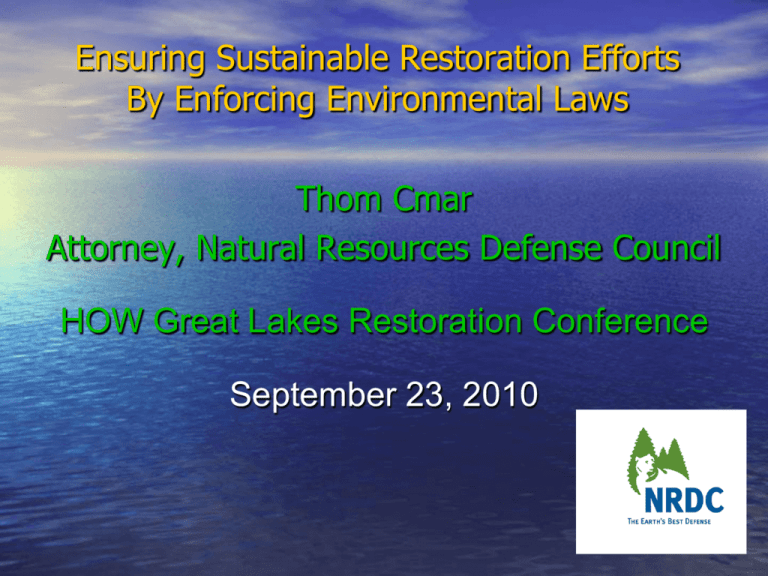
Ensuring Sustainable Restoration Efforts By Enforcing Environmental Laws Thom Cmar Attorney, Natural Resources Defense Council HOW Great Lakes Restoration Conference September 23, 2010 About • National non-profit membership group • Founded in 1970 • Mission statement: “to safeguard the Earth: its people, its plants and animals, and the natural systems on which all life depends” and “to restore the integrity of the elements that sustain life – air, land, and water – and to defend endangered natural places” About • Staff of over 300 lawyers, scientists, and technical experts • 7 offices: New York, Washington DC, Chicago, Montana, San Francisco, Santa Monica, and Beijing • Chicago office opened in January 2007 to intensify NRDC’s advocacy efforts on water and energy policy in the Midwest (including Great Lakes issues and climate change) The Clean Water Act • The CWA’s objective is “to restore and maintain • • the chemical, physical, and biological integrity of the Nation's waters” and “to eliminate[]” “the discharge of pollutants into the navigable waters.” 33 U.S.C.§1251(a) Kennecott v. U.S. EPA, 780 F.2d 445, 448 (4th Cir. 1985) (it was the “intention of Congress” in enacting the CWA “to use the latest scientific research and technology in setting effluent limits, pushing industries toward the goal of zero discharge as quickly as possible”) Critical importance of CWA is that it requires public participation and allows for citizen enforcement Four threats to the Lakes that the CWA can help solve 1. Nutrient pollution causes harmful algal blooms and degrades water quality 2. Power plants dump thermal pollution into the Lakes and kill fish in their cooling water intakes 3. Combined sewer overflows (“CSOs”) discharge harmful bacteria and pollution that fouls our waters and closes beaches 4. Vessels’ ballast water discharges introduce and spread invasive species • The GLRI addresses some aspects of these problems, but will not solve them on its own Numeric nutrient criteria • EPA has acknowledged for at least 12 years • • that numeric water quality criteria are needed to establish baseline standards for restoration and protection of nutrient-impaired waters (1998 Clean Water Action plan) Under Section 303(c) of the CWA, EPA has a non-discretionary duty to promulgate new or revised water quality standards for states if it determines that they are necessary EPA refuses to concede that it has made such a determination for nutrients, however, and is now engaging in a rulemaking to “clarify” that such determinations can only be made explicitly What can citizens do? • Numeric criteria are the lynchpin – would allow for easier development of protective permit limits for point source dischargers (such as municipal wastewater treatment plants) as well as Total Maximum Daily Loads for watersheds • Numeric criteria establish quantitative baselines against which progress can be measured, and innovative programs such as nutrient trading can be established • Citizens can petition EPA to make determinations that numeric nutrient criteria are necessary to stop harmful algal blooms in specific watersheds • NRDC joined other groups in such a petition for the Mississippi River Basin (Gulf dead zone), and we are currently evaluating one for Lake Erie What can citizens do? • Citizens can also challenge nutrient pollution • • • from Concentrated Animal Feeding Operations (“CAFOs”), which are regulated under CWA as point sources CAFOs that “discharge or propose to discharge” are required to have NPDES permits and to follow Nutrient Management Plans for proper handling of animal waste that are enforceable Many CAFOs do not have permits and can be sued on that basis – in 2008, EPA reported that over half the industry remained unpermitted Citizens can also press for smaller AFOs to be treated as CAFOs if they cause significant pollution Power plant cooling systems • The vast majority of power plants in the Great • • Lakes still use antiquated once-through cooling systems that suck up hundreds of millions of gallons of water per day and discharge it several degrees hotter The cooling water intake structures at these plants kill massive amounts of fish because they are slammed and caught against the intake screens (impingement) or because they are sucked into the plant itself through the intake (entrainment) Bayshore plant on Maumee Bay impinges 46 million adult fish per year and entrains over 2 billion fish eggs, larvae, and juveniles (recent study shows this costs local fishing economy up to $30 million per year) CWA requires better technology • CWA requires Best Available Technology to • • reduce fish kills through impingement and entrainment – EPA draft rule expected by the end of this year, but while that is pending States must decide (like New York has) CWA also requires States to regulate “heat” like any other pollutant, unless company makes a showing that it can discharge to a higher limit without harming a “balanced indigenous population” of fish, shellfish, and wildlife (not just thermally tolerant species) Otherwise, the State must require that plants use Best Available Technology to reduce thermal discharges and ensure that thermal water quality standards are met CSO pollution • CSOs occur when combined sewers are • • • overloaded with storm runoff, causing discharges of untreated sewage CSOs are concentrated heavily in the Great Lakes region – major reason why Great Lakes beaches have a pollution rate twice the national average (NRDC Testing the Waters report) CSOs also harm the aquatic ecosystem and can be a source of nutrient pollution In Chicago, where CSOs also mean flooding in people’s basements, CSOs begin to occur starting with rainfall at only 0.67 inches Long Term Control Plans and Green Infrastructure • A 2000 amendment to the CWA codifies EPA’s • • 1995 CSO Control Policy, which requires municipalities to set up Long Term Control Plans to reduce CSO pollution Municipalities that fail to comply may be subject to EPA or citizen enforcement The need to comply with the CWA can be a major driver of municipal investment in new sewage infrastructure, and can create opportunities for citizens to advocate for use of green infrastructure as cost-effective compliance method (use of natural systems instead of pipes) – major priority for NRDC Ballast water regulation • Progress has been made in recent years • Began with States (California & Michigan) • Federal court decision in California requires US EPA to regulate under federal Clean Water Act • Coast Guard has finally proposed treatment requirements after years of inaction EPA exempted vessel discharges • Less than one year after CWA was enacted, EPA • promulgated a regulation excluding discharges “incidental to the normal operation” of vessels from NPDES permitting. 38 Fed. Reg. 13,528 (May 22, 1973) (codified at 40 C.F.R.§122.3) Federal court held that this regulation was promulgated “in excess of . . . [EPA’s] statutory authority,” because plain language of CWA required regulation of ballast water and other vessel discharges. NWEA v. EPA, 2005 WL 756614, at *13 (N.D. Cal. Mar. 30, 2005), aff’d, 537 F.3d 1006 (9th Cir. 2008) EPA Vessel General Permit • In December 2008, in response to NWEA, EPA • • • finalized Vessel General Permit to regulate 26 different “discharge streams,” including ballast VGP does not require vessels to take any significant steps beyond compliance with existing Coast Guard and Seaway regulations to reduce their discharges of invasive species Does not live up to CWA: no further Best Available Technology TBELs, no real WQBELs NRDC and others are litigating in DC Circuit CWA Section 401 Certifications • Section 401 of the CWA requires that “[a]ny applicant • • • • for a Federal license or permit to conduct any activity . . . which may result in a discharge into the navigable waters,” such as the VGP, be certified by States for compliance with state water quality standards Provisions included by State in Section 401 certification “become a condition” on federal permit itself, federally enforceable New York has required new vessels to meet 1000x IMO standards and existing vessels to meet 100x IMO standards Port of Oswego v. Grannis – NRDC intervened and helped defend challenge to New York 401 certification Other states have added conditions under Section 401 Proposed Coast Guard rule • Coast Guard has proposed ballast water • • • discharge standards under NISA – 74 Fed. Reg. 44,632 Two-phase discharge standards: Phase I IMO, Phase II 1000x IMO (subject to practicability review) Concerns about compliance timelines, potential for further delays through practicability review Not clear how/if Coast Guard will coordinate with EPA and help enforce more stringent standards required by CWA How the CWA can help 1. Creates a binding legal mandate that drives change and creates incentives to innovate 2. Rigorous, scientifically based standards that put environmental protection first 3. Public comment and public participation are required 4. Citizens can act as “private attorneys general” to enforce the law when agencies do not thank you Thom Cmar (312) 663-9900 tcmar@nrdc.org

